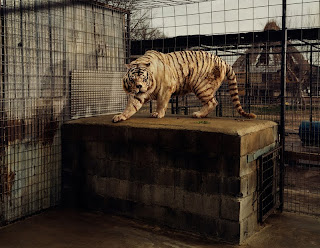 Lately in my random internet searches for tidbits on lions and tigers, I've come across some stunning work! The three artists that I'm choosing to highlight here are Uffe Christoffersen (Tigerwalk 3, oil painting/ computer art, far left), Nick Brandt (Lions Head to Head, photograph, left) and Taryn Simon. Read my full entry to learn more and to see more beautiful work from these three masterminds.
Lately in my random internet searches for tidbits on lions and tigers, I've come across some stunning work! The three artists that I'm choosing to highlight here are Uffe Christoffersen (Tigerwalk 3, oil painting/ computer art, far left), Nick Brandt (Lions Head to Head, photograph, left) and Taryn Simon. Read my full entry to learn more and to see more beautiful work from these three masterminds.UFFE CHRISTOFFERSEN
 "Uffe Christoffersen is a figurative artist in the true sense of the word. Christoffersen...has become known for his colourful representations of wild animals, especially concentrating on the individual animal’s characteristics:- shape, colour, texture, movement, and most difficult of all, the psyche of the wild animal. Like many of his generation’s artists he has rediscovered painting as a means of expression. His treatment of oil paint as a medium is very consciously full of colour nuances...his interest for animal life contains a warm affection for nature which is in constant threat of destruction because of man’s misuse." —Uffe Christoffersen's official website. At right: Tigerwalk 2, oil painting/ computer art.
"Uffe Christoffersen is a figurative artist in the true sense of the word. Christoffersen...has become known for his colourful representations of wild animals, especially concentrating on the individual animal’s characteristics:- shape, colour, texture, movement, and most difficult of all, the psyche of the wild animal. Like many of his generation’s artists he has rediscovered painting as a means of expression. His treatment of oil paint as a medium is very consciously full of colour nuances...his interest for animal life contains a warm affection for nature which is in constant threat of destruction because of man’s misuse." —Uffe Christoffersen's official website. At right: Tigerwalk 2, oil painting/ computer art.NICK BRANDT
From a recent feature in the UK's Conde Nast Traveler: "London-born photographer Nick Brandt believes animals are as worthy of life as humans. His portraits of them are elegant and intimate, depicting a dream-like world of beauty, strength and vulnerability. But he has an urgent mission: he wants to help raise awareness of the issues that are putting these magnificent creatures under threat, and capture the majesty of East African wildlife before it disappears."
 From left: Lioness looking over plains, Masai Mara, 2004. Sitting lionesses, Serengeti, 2002. View these and many more at Brandt's offical website.
From left: Lioness looking over plains, Masai Mara, 2004. Sitting lionesses, Serengeti, 2002. View these and many more at Brandt's offical website.TARYN SIMON
 Simon doesn't specialize in photographing big cats. However, her recent series An American Index: The Hidden and Unfamiliar marked a big step in educating the public about big cats in captivity. The series included a photograph of Kenny, an adult white tiger who was conceived as the result of irresponsible inbreeding. As a result, Kenny lived his life with many deformities, including mental retardation, malformed teeth, abnormal bone structure and a deep-set nosed that caused breathing difficulties.
Simon doesn't specialize in photographing big cats. However, her recent series An American Index: The Hidden and Unfamiliar marked a big step in educating the public about big cats in captivity. The series included a photograph of Kenny, an adult white tiger who was conceived as the result of irresponsible inbreeding. As a result, Kenny lived his life with many deformities, including mental retardation, malformed teeth, abnormal bone structure and a deep-set nosed that caused breathing difficulties.Simon's series highlights a number of American pseudo-secrets: concepts, places and facilities that are kept somewhat under wraps... Crumbs of the American apple pie that are swept under a shiny red, white and blue rug. Other photographs in the Hidden and Unfamiliar series feature a cryopreservation unit, art on display at the CIA Headquarters, and a marijuana research crop room at the National Center for Natural Products Research. What prompted her idea for this series? "After September 11th, when the American government and media was so deeply invested in finding secret sites (the inaccessible) beyond its borders, I decided to look inward—to find the hidden and unfamiliar, the out-of-view and off-the-radar within American borders." To view more of Taryn's work, visit her official website.
Why not do a quick search for "big cat art" and see what images you can find? Will you see majesty? Inspiration? Sadness? I guarantee that if you look hard enough, you will find some unexpected way to relate to these endangered gems that we hold close to our hearts.
Read full entry

 This August, I began working on a paper for
This August, I began working on a paper for 



 The new Sapna cover is up, along with a number of new features. One of my favorite pieces is an interview with Sonal Shah, who stars in TV's hit show
The new Sapna cover is up, along with a number of new features. One of my favorite pieces is an interview with Sonal Shah, who stars in TV's hit show 









 I always need a creative outlet to express myself. Not that vet school and Sapna Magazine don't keep me busy enough -- it's just nice to have a variety sometimes. To that end, and I've decided to launch a line of free blogger templates!
I always need a creative outlet to express myself. Not that vet school and Sapna Magazine don't keep me busy enough -- it's just nice to have a variety sometimes. To that end, and I've decided to launch a line of free blogger templates!








